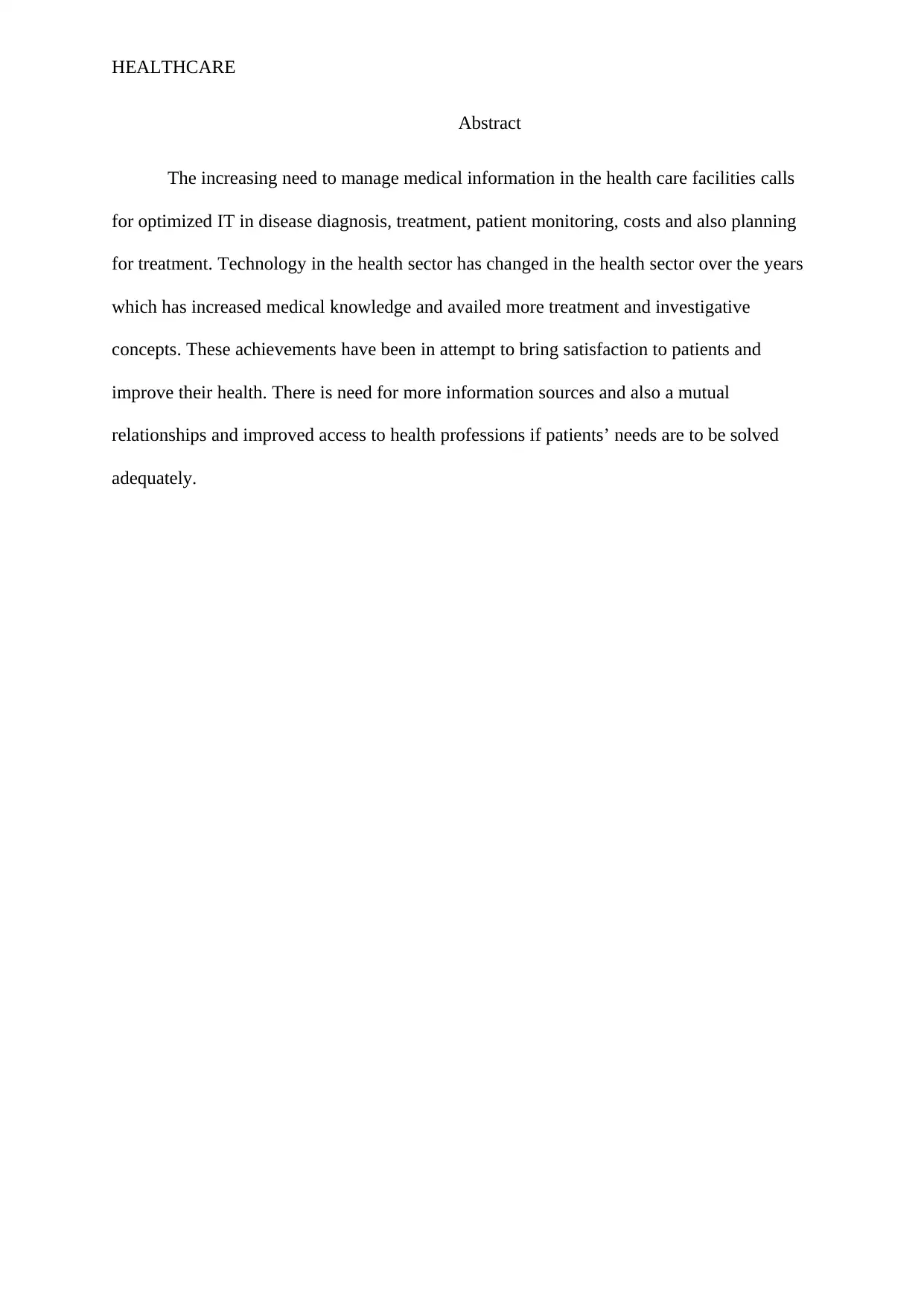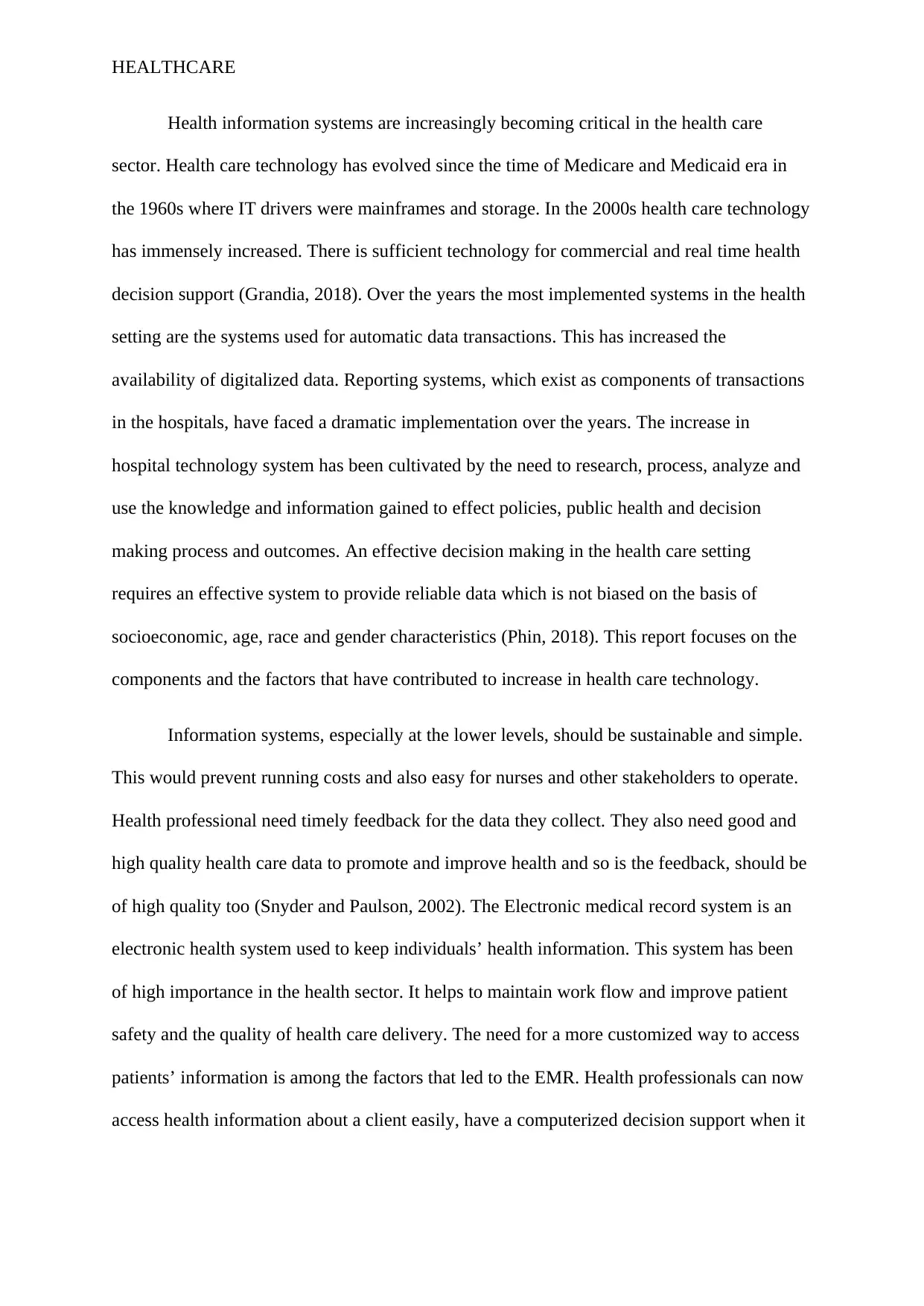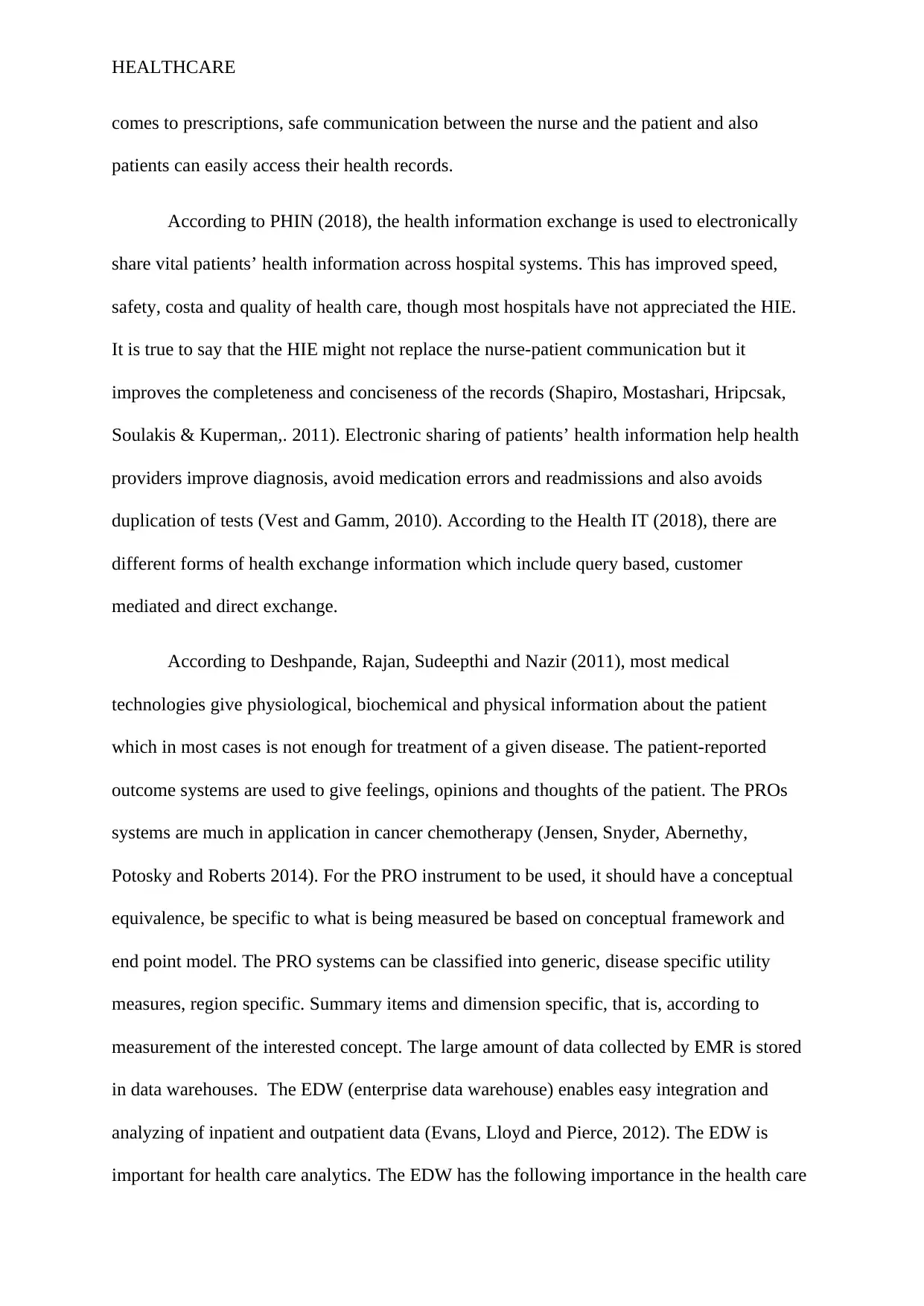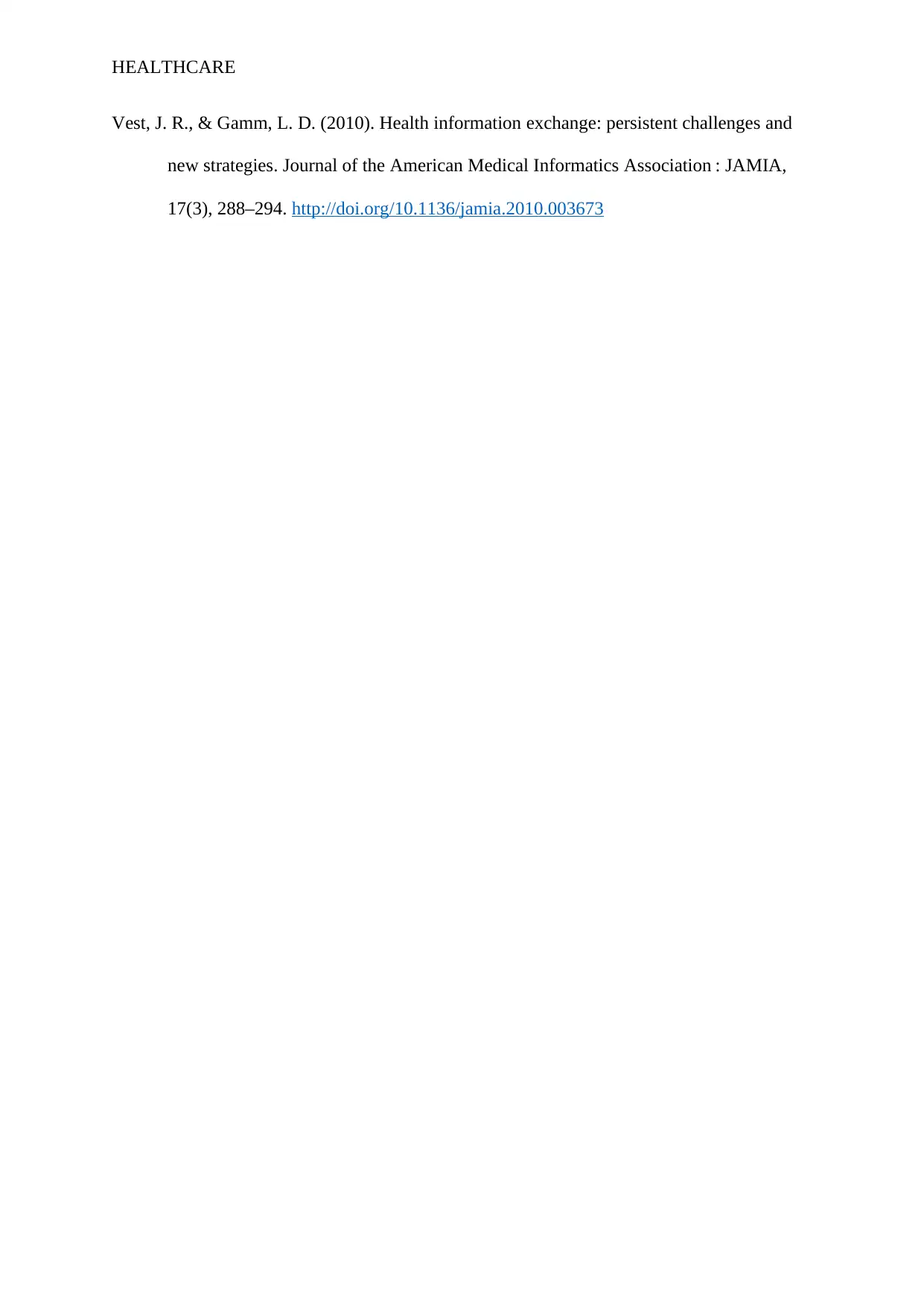Health Care Technology: The Impact of IT on Modern Health Systems
VerifiedAdded on 2023/06/04
|7
|1246
|366
Report
AI Summary
This report examines the increasing importance of health information systems in modern healthcare, tracing the evolution of technology from the Medicare and Medicaid era to the present day. It highlights the implementation of automated data transaction systems and reporting systems in hospitals, driven by the need for research, analysis, and informed decision-making. The report discusses the role of Electronic Medical Records (EMR) in improving patient safety and healthcare delivery, as well as the impact of Health Information Exchange (HIE) in electronically sharing patient data across hospital systems. It also explores the use of Patient-Reported Outcome (PRO) systems for capturing patient feelings and opinions, and the significance of Enterprise Data Warehouses (EDW) in integrating and analyzing healthcare data for improved system performance and quality of care. This document is available on Desklib, a platform offering a wide range of study resources for students.

Running head: HEALTHCARE
Student name
Student No
Unit
Title: Health Care Technology
Student name
Student No
Unit
Title: Health Care Technology
Paraphrase This Document
Need a fresh take? Get an instant paraphrase of this document with our AI Paraphraser

HEALTHCARE
Abstract
The increasing need to manage medical information in the health care facilities calls
for optimized IT in disease diagnosis, treatment, patient monitoring, costs and also planning
for treatment. Technology in the health sector has changed in the health sector over the years
which has increased medical knowledge and availed more treatment and investigative
concepts. These achievements have been in attempt to bring satisfaction to patients and
improve their health. There is need for more information sources and also a mutual
relationships and improved access to health professions if patients’ needs are to be solved
adequately.
Abstract
The increasing need to manage medical information in the health care facilities calls
for optimized IT in disease diagnosis, treatment, patient monitoring, costs and also planning
for treatment. Technology in the health sector has changed in the health sector over the years
which has increased medical knowledge and availed more treatment and investigative
concepts. These achievements have been in attempt to bring satisfaction to patients and
improve their health. There is need for more information sources and also a mutual
relationships and improved access to health professions if patients’ needs are to be solved
adequately.

HEALTHCARE
Health information systems are increasingly becoming critical in the health care
sector. Health care technology has evolved since the time of Medicare and Medicaid era in
the 1960s where IT drivers were mainframes and storage. In the 2000s health care technology
has immensely increased. There is sufficient technology for commercial and real time health
decision support (Grandia, 2018). Over the years the most implemented systems in the health
setting are the systems used for automatic data transactions. This has increased the
availability of digitalized data. Reporting systems, which exist as components of transactions
in the hospitals, have faced a dramatic implementation over the years. The increase in
hospital technology system has been cultivated by the need to research, process, analyze and
use the knowledge and information gained to effect policies, public health and decision
making process and outcomes. An effective decision making in the health care setting
requires an effective system to provide reliable data which is not biased on the basis of
socioeconomic, age, race and gender characteristics (Phin, 2018). This report focuses on the
components and the factors that have contributed to increase in health care technology.
Information systems, especially at the lower levels, should be sustainable and simple.
This would prevent running costs and also easy for nurses and other stakeholders to operate.
Health professional need timely feedback for the data they collect. They also need good and
high quality health care data to promote and improve health and so is the feedback, should be
of high quality too (Snyder and Paulson, 2002). The Electronic medical record system is an
electronic health system used to keep individuals’ health information. This system has been
of high importance in the health sector. It helps to maintain work flow and improve patient
safety and the quality of health care delivery. The need for a more customized way to access
patients’ information is among the factors that led to the EMR. Health professionals can now
access health information about a client easily, have a computerized decision support when it
Health information systems are increasingly becoming critical in the health care
sector. Health care technology has evolved since the time of Medicare and Medicaid era in
the 1960s where IT drivers were mainframes and storage. In the 2000s health care technology
has immensely increased. There is sufficient technology for commercial and real time health
decision support (Grandia, 2018). Over the years the most implemented systems in the health
setting are the systems used for automatic data transactions. This has increased the
availability of digitalized data. Reporting systems, which exist as components of transactions
in the hospitals, have faced a dramatic implementation over the years. The increase in
hospital technology system has been cultivated by the need to research, process, analyze and
use the knowledge and information gained to effect policies, public health and decision
making process and outcomes. An effective decision making in the health care setting
requires an effective system to provide reliable data which is not biased on the basis of
socioeconomic, age, race and gender characteristics (Phin, 2018). This report focuses on the
components and the factors that have contributed to increase in health care technology.
Information systems, especially at the lower levels, should be sustainable and simple.
This would prevent running costs and also easy for nurses and other stakeholders to operate.
Health professional need timely feedback for the data they collect. They also need good and
high quality health care data to promote and improve health and so is the feedback, should be
of high quality too (Snyder and Paulson, 2002). The Electronic medical record system is an
electronic health system used to keep individuals’ health information. This system has been
of high importance in the health sector. It helps to maintain work flow and improve patient
safety and the quality of health care delivery. The need for a more customized way to access
patients’ information is among the factors that led to the EMR. Health professionals can now
access health information about a client easily, have a computerized decision support when it
⊘ This is a preview!⊘
Do you want full access?
Subscribe today to unlock all pages.

Trusted by 1+ million students worldwide

HEALTHCARE
comes to prescriptions, safe communication between the nurse and the patient and also
patients can easily access their health records.
According to PHIN (2018), the health information exchange is used to electronically
share vital patients’ health information across hospital systems. This has improved speed,
safety, costa and quality of health care, though most hospitals have not appreciated the HIE.
It is true to say that the HIE might not replace the nurse-patient communication but it
improves the completeness and conciseness of the records (Shapiro, Mostashari, Hripcsak,
Soulakis & Kuperman,. 2011). Electronic sharing of patients’ health information help health
providers improve diagnosis, avoid medication errors and readmissions and also avoids
duplication of tests (Vest and Gamm, 2010). According to the Health IT (2018), there are
different forms of health exchange information which include query based, customer
mediated and direct exchange.
According to Deshpande, Rajan, Sudeepthi and Nazir (2011), most medical
technologies give physiological, biochemical and physical information about the patient
which in most cases is not enough for treatment of a given disease. The patient-reported
outcome systems are used to give feelings, opinions and thoughts of the patient. The PROs
systems are much in application in cancer chemotherapy (Jensen, Snyder, Abernethy,
Potosky and Roberts 2014). For the PRO instrument to be used, it should have a conceptual
equivalence, be specific to what is being measured be based on conceptual framework and
end point model. The PRO systems can be classified into generic, disease specific utility
measures, region specific. Summary items and dimension specific, that is, according to
measurement of the interested concept. The large amount of data collected by EMR is stored
in data warehouses. The EDW (enterprise data warehouse) enables easy integration and
analyzing of inpatient and outpatient data (Evans, Lloyd and Pierce, 2012). The EDW is
important for health care analytics. The EDW has the following importance in the health care
comes to prescriptions, safe communication between the nurse and the patient and also
patients can easily access their health records.
According to PHIN (2018), the health information exchange is used to electronically
share vital patients’ health information across hospital systems. This has improved speed,
safety, costa and quality of health care, though most hospitals have not appreciated the HIE.
It is true to say that the HIE might not replace the nurse-patient communication but it
improves the completeness and conciseness of the records (Shapiro, Mostashari, Hripcsak,
Soulakis & Kuperman,. 2011). Electronic sharing of patients’ health information help health
providers improve diagnosis, avoid medication errors and readmissions and also avoids
duplication of tests (Vest and Gamm, 2010). According to the Health IT (2018), there are
different forms of health exchange information which include query based, customer
mediated and direct exchange.
According to Deshpande, Rajan, Sudeepthi and Nazir (2011), most medical
technologies give physiological, biochemical and physical information about the patient
which in most cases is not enough for treatment of a given disease. The patient-reported
outcome systems are used to give feelings, opinions and thoughts of the patient. The PROs
systems are much in application in cancer chemotherapy (Jensen, Snyder, Abernethy,
Potosky and Roberts 2014). For the PRO instrument to be used, it should have a conceptual
equivalence, be specific to what is being measured be based on conceptual framework and
end point model. The PRO systems can be classified into generic, disease specific utility
measures, region specific. Summary items and dimension specific, that is, according to
measurement of the interested concept. The large amount of data collected by EMR is stored
in data warehouses. The EDW (enterprise data warehouse) enables easy integration and
analyzing of inpatient and outpatient data (Evans, Lloyd and Pierce, 2012). The EDW is
important for health care analytics. The EDW has the following importance in the health care
Paraphrase This Document
Need a fresh take? Get an instant paraphrase of this document with our AI Paraphraser

HEALTHCARE
sector increased system performance, timely data access, enhanced health care intelligence
and improved quality of health care delivery.
sector increased system performance, timely data access, enhanced health care intelligence
and improved quality of health care delivery.

HEALTHCARE
References
Deshpande, P. R., Rajan, S., Sudeepthi, B. L., & Abdul Nazir, C. P. (2011). Patient-reported
outcomes: A new era in clinical research. Perspectives in Clinical Research, 2(4),
137–144. http://doi.org/10.4103/2229-3485.86879
Evans, R. S., Lloyd, J. F., & Pierce, L. A. (2012). Clinical Use of an Enterprise Data
Warehouse. AMIA Annual Symposium Proceedings, 2012, 189–198.
Grandia, L. (2018). Healthcare Information Systems: A Look at the Past, Present, and Future.
Retrieved from: https://www.healthcatalyst.com/insights/healthcare-information-
systems-past-present-future
HealthIT. (2018). What is HIE? Retrieved from: https://www.healthit.gov/topic/health-it-and-
health-information-exchange-basics/what-hie
Jensen, R. E, Snyder, C. F, Abernethy, A. P., Potosky, A. L. and Roberts A. C. (2014).
Review of Electronic Patient-Reported Outcomes Systems Used in Cancer Clinical
Care. Journal of Oncology Practice, Vol. 10, No. 4, pp. 215-22. Doi:
10.1200/JOP.2013.001067 Pacific Health Information Network (PHIN). (2018).
Health information systems (HIS). Retrieved from:
http://phinnetwork.org/resources/health-information-systems-his/
Snyder, K. D. and Paulson, P. (2002). Healthcare information systems: analysis of healthcare
software. The NCBI, Vol. 80, No. 4, pp. 5-12. Doi: 10.1080/00185860209598004
Shapiro, J. S., Mostashari, F., Hripcsak, G., Soulakis, N., & Kuperman, G. (2011). Using
Health Information Exchange to Improve Public Health. American Journal of Public
Health, 101(4), 616–623. http://doi.org/10.2105/AJPH.2008.158980
References
Deshpande, P. R., Rajan, S., Sudeepthi, B. L., & Abdul Nazir, C. P. (2011). Patient-reported
outcomes: A new era in clinical research. Perspectives in Clinical Research, 2(4),
137–144. http://doi.org/10.4103/2229-3485.86879
Evans, R. S., Lloyd, J. F., & Pierce, L. A. (2012). Clinical Use of an Enterprise Data
Warehouse. AMIA Annual Symposium Proceedings, 2012, 189–198.
Grandia, L. (2018). Healthcare Information Systems: A Look at the Past, Present, and Future.
Retrieved from: https://www.healthcatalyst.com/insights/healthcare-information-
systems-past-present-future
HealthIT. (2018). What is HIE? Retrieved from: https://www.healthit.gov/topic/health-it-and-
health-information-exchange-basics/what-hie
Jensen, R. E, Snyder, C. F, Abernethy, A. P., Potosky, A. L. and Roberts A. C. (2014).
Review of Electronic Patient-Reported Outcomes Systems Used in Cancer Clinical
Care. Journal of Oncology Practice, Vol. 10, No. 4, pp. 215-22. Doi:
10.1200/JOP.2013.001067 Pacific Health Information Network (PHIN). (2018).
Health information systems (HIS). Retrieved from:
http://phinnetwork.org/resources/health-information-systems-his/
Snyder, K. D. and Paulson, P. (2002). Healthcare information systems: analysis of healthcare
software. The NCBI, Vol. 80, No. 4, pp. 5-12. Doi: 10.1080/00185860209598004
Shapiro, J. S., Mostashari, F., Hripcsak, G., Soulakis, N., & Kuperman, G. (2011). Using
Health Information Exchange to Improve Public Health. American Journal of Public
Health, 101(4), 616–623. http://doi.org/10.2105/AJPH.2008.158980
⊘ This is a preview!⊘
Do you want full access?
Subscribe today to unlock all pages.

Trusted by 1+ million students worldwide

HEALTHCARE
Vest, J. R., & Gamm, L. D. (2010). Health information exchange: persistent challenges and
new strategies. Journal of the American Medical Informatics Association : JAMIA,
17(3), 288–294. http://doi.org/10.1136/jamia.2010.003673
Vest, J. R., & Gamm, L. D. (2010). Health information exchange: persistent challenges and
new strategies. Journal of the American Medical Informatics Association : JAMIA,
17(3), 288–294. http://doi.org/10.1136/jamia.2010.003673
1 out of 7
Related Documents
Your All-in-One AI-Powered Toolkit for Academic Success.
+13062052269
info@desklib.com
Available 24*7 on WhatsApp / Email
![[object Object]](/_next/static/media/star-bottom.7253800d.svg)
Unlock your academic potential
Copyright © 2020–2025 A2Z Services. All Rights Reserved. Developed and managed by ZUCOL.





